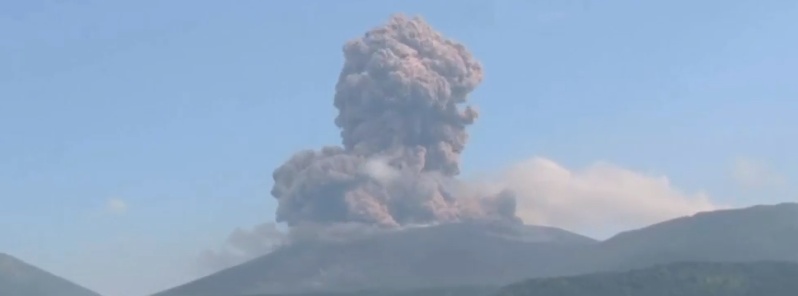Explosive eruption at Shinmoedake volcano (Kirishimayama), Japan

A new explosive eruption took place at Japan's Shinmoedake volcano, a part of Kirishimayama volcanic complex, at 00:09 UTC (09:09 JST) on June 22, 2018. This was its first explosive eruption since May 14.
The eruption ejected a column of ash up to 4.6 km (14 000 feet) above sea level, according to the Tokyo VAAC. Volcanic material was thrown as far as 1.1 km (0.7 miles) from the crater.
Impressive explosive eruption at #Kirishima #Shinmoedake #volcano in #Japan 10 minutes ago! #霧島 #新燃岳 #火山 pic.twitter.com/draKs5juMV
— James Reynolds (@EarthUncutTV) June 22, 2018

This was the first explosive eruption of this volcano since 05:44 UTC on May 14. That eruption sent ash up to 7.6 km (25 000 feet) above sea level, making it nearly 1 km higher than April 4th eruption and the highest since the current eruptive phase of this volcano began on March 1, 2018.
According to Tokyo VAAC, the volcanic ash was continually observed up until 11:20 UTC on May 15.




The Japan Meteorological Agency (JMA) maintains the alert level at 3 since March 15. This level means people should stay away from the mountain and remain cautious of falling large rocks within a 3-km (1.8 miles) radius of the crater.
Geological summary
Kirishimayama is a large group of more than 20 Quaternary volcanoes located north of Kagoshima Bay. The late-Pleistocene to Holocene dominantly andesitic group consists of stratovolcanoes, pyroclastic cones, maars, and underlying shield volcanoes located over an area of 20 x 30 km (12.4 – 18.6 miles).
The larger stratovolcanoes are scattered throughout the field, with the centrally located, 1700-m-high (5 577 feet) Karakunidake being the highest.
Onamiike and Miike, the two largest maars, are located SW of Karakunidake and at its far eastern end, respectively.
Holocene eruptions have been concentrated along an E-W line of vents from Miike to Ohachi, and at Shinmoedake to the NE. Frequent small-to-moderate explosive eruptions have been recorded since the 8th century. (GVP)
Featured image credit: MORI MORI

Earth’s magnetic field is under huge stress due to cosmic rays bombardment. And the rate of cosmic rays will increase drastically in the time to come, since the Sun is approaching its highest point in the galaxy. Beside that, in the second half of July there will be an astronomical event that will put earth’s magnetic field under further stress.